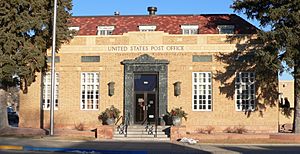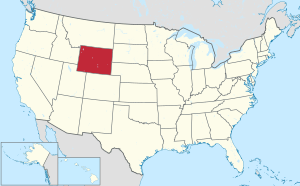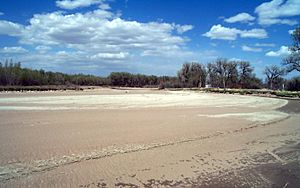Goshen County, Wyoming facts for kids
Quick facts for kids
Goshen County
|
||
|---|---|---|

United States Post Office (Torrington, Wyoming)
|
||
|
||

Location within the U.S. state of Wyoming
|
||
 Wyoming's location within the U.S. |
||
| Country | ||
| State | ||
| Founded | February 21, 1911 (authorized) 1913 (organized) |
|
| Named for | Land of Goshen | |
| Seat | Torrington | |
| Largest city | Torrington | |
| Area | ||
| • Total | 2,232 sq mi (5,780 km2) | |
| • Land | 2,225 sq mi (5,760 km2) | |
| • Water | 6.8 sq mi (18 km2) 0.3%% | |
| Population
(2020)
|
||
| • Total | 12,498 | |
| • Density | 5.5995/sq mi (2.1620/km2) | |
| Time zone | UTC−7 (Mountain) | |
| • Summer (DST) | UTC−6 (MDT) | |
| Congressional district | At-large | |
Goshen County (/ˈɡoʊʃən/, GOH-shən) is a county in the U.S. state of Wyoming. As of the 2020 United States Census, the population was 12,498. Its county seat is Torrington. The eastern boundary of the County borders the Nebraska state line.
Goshen County produces more cattle than any other Wyoming county. In 1997, the county had a total of 688 farms and ranches, averaging 1,840 acres. As of 2007, this had declined slightly to 665 farms and ranches in the county.
Contents
History
Goshen County was created in 1911 from a portion of Laramie County. Its government was organized in 1913. This area was part of territories, at one time or another, claimed by: Spain, France, Great Britain, Mexico, and the Republic of Texas. The Louisiana Purchase in 1803 permanently established the claim of the United States to the area.
By the 1820s, the North Platte River had become a route for westward-bound fur traders and trappers. By the 1840s this route became part of the Oregon Trail or Mormon Trail. By the late 1850s, it was the route for regularly scheduled east–west stagecoaches carrying passengers and the U.S. mail, and for the short-lived Pony Express carrying mail from Missouri to California (April 1860 to November 1861). By October 1861, transcontinental telegraph lines had been completed along the route. From September 1876 to February 1887, a north–south, Cheyenne-Deadwood stage coach line ran through the county from Cheyenne to the gold fields of the Dakota Territory.
The county was apparently named for Goshen Hole, a valley in the southwest part of the county. John C. Frémont camped in that area on July 14, 1843, and recorded that name in his journal, during an expedition on the Oregon Trail. At least four conflicting stories are available for the origin of the name "Goshen Hole". The Land of Goshen in Egypt, mentioned in the 45th chapter of the Genesis in the Bible, has been suggested as the most likely. And, John Hunton, who was ranching in the area by the 1870s, was told by Seth Ward, the post sutler at Fort Laramie, that the area was named for the Biblical land. The name of Goshen Hole first appeared on a map years later, in 1888.
Geography
According to the US Census Bureau, the county has a total area of 2,232 square miles (5,780 km2), of which 2,225 square miles (5,760 km2) is land and 6.8 square miles (18 km2) (0.3%) is water. The county is situated in the High Plains east of the Rocky Mountains.
Adjacent counties
- Niobrara County - north
- Platte County - west
- Laramie County - south
- Banner County, Nebraska - southeast
- Scotts Bluff County, Nebraska - east
- Sioux County, Nebraska - east
National protected area
Climate

Situated on the North Platte River, Goshen County has a semi-arid climate (Köppen climate classification BSk.)
| Climate data for Torrington, Wyoming | |||||||||||||
|---|---|---|---|---|---|---|---|---|---|---|---|---|---|
| Month | Jan | Feb | Mar | Apr | May | Jun | Jul | Aug | Sep | Oct | Nov | Dec | Year |
| Record high °F (°C) | 70 (21) |
75 (24) |
85 (29) |
91 (33) |
100 (38) |
105 (41) |
111 (44) |
105 (41) |
101 (38) |
92 (33) |
83 (28) |
77 (25) |
111 (44) |
| Mean daily maximum °F (°C) | 39.5 (4.2) |
45.0 (7.2) |
52.0 (11.1) |
61.2 (16.2) |
71.0 (21.7) |
82.4 (28.0) |
89.1 (31.7) |
87.3 (30.7) |
77.7 (25.4) |
65.4 (18.6) |
49.2 (9.6) |
41.0 (5.0) |
63.4 (17.5) |
| Daily mean °F (°C) | 24.9 (−3.9) |
30.0 (−1.1) |
37.5 (3.1) |
46.0 (7.8) |
56.2 (13.4) |
66.3 (19.1) |
72.3 (22.4) |
70.2 (21.2) |
59.8 (15.4) |
47.6 (8.7) |
34.0 (1.1) |
26.2 (−3.2) |
47.6 (8.7) |
| Mean daily minimum °F (°C) | 10.3 (−12.1) |
14.9 (−9.5) |
23.0 (−5.0) |
30.7 (−0.7) |
41.3 (5.2) |
50.2 (10.1) |
55.5 (13.1) |
53.1 (11.7) |
41.9 (5.5) |
29.7 (−1.3) |
18.8 (−7.3) |
11.3 (−11.5) |
31.7 (−0.2) |
| Record low °F (°C) | −39 (−39) |
−33 (−36) |
−26 (−32) |
−17 (−27) |
11 (−12) |
29 (−2) |
39 (4) |
32 (0) |
14 (−10) |
−9 (−23) |
−23 (−31) |
−43 (−42) |
−43 (−42) |
| Average precipitation inches (mm) | 0.31 (7.9) |
0.40 (10) |
0.70 (18) |
1.68 (43) |
2.54 (65) |
2.09 (53) |
1.78 (45) |
1.19 (30) |
1.27 (32) |
0.95 (24) |
0.57 (14) |
0.36 (9.1) |
13.84 (351) |
| Average snowfall inches (cm) | 4.8 (12) |
4.9 (12) |
4.9 (12) |
3.2 (8.1) |
0.1 (0.25) |
0.0 (0.0) |
0.0 (0.0) |
0.0 (0.0) |
0.4 (1.0) |
2.1 (5.3) |
4.8 (12) |
6.8 (17) |
32 (79.65) |
| Average precipitation days (≥ 0.01 inch) | 4.3 | 3.5 | 5.3 | 7.5 | 9.8 | 8.7 | 7.6 | 6.3 | 5.9 | 4.7 | 4.0 | 3.9 | 71.5 |
| Average snowy days (≥ 0.1 inch) | 3.8 | 2.8 | 2.5 | 1.3 | 0.2 | 0.0 | 0.0 | 0.0 | 0.2 | 0.8 | 2.4 | 3.6 | 17.6 |
| Source 1: NOAA (normals, 1971–2000) | |||||||||||||
| Source 2: The Weather Channel (Records) NOAA NNDC Climate Data | |||||||||||||
On June 5, 2009, a weather research team known as VORTEX2 observed and measured the full life cycle of a tornado in eastern Goshen County.
Demographics
| Historical population | |||
|---|---|---|---|
| Census | Pop. | %± | |
| 1920 | 8,064 | — | |
| 1930 | 11,754 | 45.8% | |
| 1940 | 12,207 | 3.9% | |
| 1950 | 12,634 | 3.5% | |
| 1960 | 11,941 | −5.5% | |
| 1970 | 10,885 | −8.8% | |
| 1980 | 12,040 | 10.6% | |
| 1990 | 12,373 | 2.8% | |
| 2000 | 12,538 | 1.3% | |
| 2010 | 13,249 | 5.7% | |
| 2020 | 12,498 | −5.7% | |
| 2023 (est.) | 12,642 | −4.6% | |
| US Decennial Census 1870–2000 2010 2020 |
|||
2010 census
As of the 2010 United States Census, there were 13,249 people, 5,311 households, and 3,466 families in the county. The population density was 6.0 people per square mile (2.3 people/km2). There were 5,972 housing units at an average density of 2.7 units per square mile (1.0 units/km2). The racial makeup of the county was 94.5% white, 0.8% American Indian, 0.6% black or African American, 0.3% Asian, 0.1% Pacific islander, 2.4% from other races, and 1.2% from two or more races. Those of Hispanic or Latino origin made up 9.7% of the population. In terms of ancestry, 38.3% were German, 15.5% were Irish, 15.3% were English, and 5.1% were American.
Of the 5,311 households, 26.4% had children under the age of 18 living with them, 53.1% were married couples living together, 7.9% had a female householder with no husband present, 34.7% were non-families, and 30.0% of all households were made up of individuals. The average household size was 2.29 and the average family size was 2.82. The median age was 43.6 years.
The median income for a household in the county was $42,590 and the median income for a family was $51,978. Males had a median income of $38,247 versus $25,277 for females. The per capita income for the county was $23,753. About 7.2% of families and 13.1% of the population were below the poverty line, including 21.3% of those under age 18 and 5.9% of those age 65 or over.
Communities
City
- Torrington (county seat)
Towns
Census-designated places
Unincorporated communities
- Jay Em
- Rockeagle
Transportation
Highways
U.S. Highways
 US 26
US 26 US 85
US 85
State Routes
 WYO 92 (Huntley Road)
WYO 92 (Huntley Road) WYO 151 (LaGrange Road)
WYO 151 (LaGrange Road) WYO 152 (Yoder Road)
WYO 152 (Yoder Road) WYO 153 (Springer Reservoir Road)
WYO 153 (Springer Reservoir Road) WYO 154 (Veteran Road)
WYO 154 (Veteran Road) WYO 156 (Sugar Factory Road)
WYO 156 (Sugar Factory Road) WYO 158 (Horse Creek Road)
WYO 158 (Horse Creek Road) WYO 159 (Van Tassell Road)
WYO 159 (Van Tassell Road) WYO 160 (Old Fort Laramie Road)
WYO 160 (Old Fort Laramie Road) WYO 161 (Yoder-Huntley Road)
WYO 161 (Yoder-Huntley Road) WYO 313 (Chugwater Road)
WYO 313 (Chugwater Road)
Airport
- Torrington Municipal Airport (TOR) – Torrington
See also
 In Spanish: Condado de Goshen para niños
In Spanish: Condado de Goshen para niños


